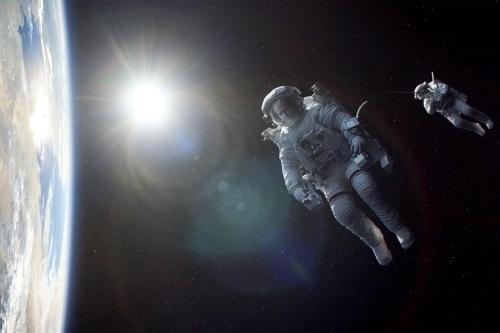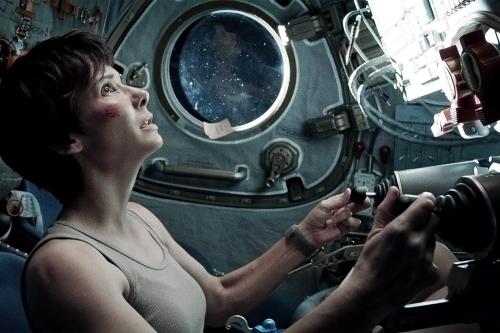Gravity is not a science fiction film.[1] And by that I mean no detriment either to it or to a genre for which I have a great deal of affection and admiration. Rather, it’s simply not the most useful way of describing a picture whose most obvious neighbour is Ron Howard’s Apollo 13 (still utterly gripping 20 years later, by the way), and which, out of this year’s cinematic offerings, probably has more in common with All is Lost than it does with Elysium or Ender’s Game.[2] The events of the film do not require future technology or alien interference (not that these are the only markers of SF); something that could very possibly go wrong in real life goes wrong, in the style of any Hollywood thriller; and experienced astronaut Matt Kowalski (George Clooney, Ocean’s Eleven, The Descendants) and Mission Specialist Dr. Ryan Stone (Sandra Bullock, Miss Congeniality, The Blind Side) have to deal with the consequences. It just so happens that they’re in space – where life, we are told, is impossible.
Certainly, the film plays fast and loose with orbital mechanics.[3] Significant details concerning the relationship between the Hubble Space Telescope, the International Space Station and the Chinese space station Tiangong (primarily the sheer scale of the distances between them and the variations in their orbits) are heavily simplified. Rather than differentiate the world of Gravity from the reality of our own, however, this is done simply to make the film’s story more comprehensible. While this may hint of typical Hollywood indulgence of lowest-common-denominator thinking, it allows the audience to more easily grasp the stakes, so that when the rug is pulled out from beneath us, the shock is all the more effective.
And shock is one of the key ingredients which makes Gravity work. Not in the schlocky sense of a jump scare in some lesser horror movie, where tension is discarded in order to go for the cheap fright, but by making the film’s spectacular sequences a visceral and emotional experience, not just a display of computer-generated effects. Alfonso Cuarón directs the film’s carefully choreographed zero-g set pieces with both assured confidence and no small amount of flair, and the clarity of the action adds to the sense of both wonder and threat, offering a contrast to the recent popular use of documentary-style ‘shaky cam’ to convey a sense of realism.[4]
However, this is also Bullock’s film, and though the dialogue is occasionally on the blunt side (a slight chink in the armour of an otherwise perfectly constructed narrative), her character grounds the action not just through offering the perspective of the outsider, but by providing the emotional centre of the entire experience. Her journey – and the film is a journey, more than you might expect – hits the traditional beats of a battle for self-preservation leading to the rediscovery of purpose and meaning. But somehow the extraordinary nature of her circumstances and the hostile nature of her surroundings underscores the primal appeal of that narrative as a kind of ritual, repeating the fact of our own existence back to us.
That’s why it’s important that Gravity is not a science fiction film. Because life in space is impossible. Yet here we are.
Gravity opens in the UK today.
___________________________________________________________
[1] Proving, once again, that you can’t always believe what you read on Wikipedia.
[2] Amusingly, according to Howard, one response card from the test previews for Apollo 13 complained that the conclusion of the film smacked of a typical Hollywood happy ending, and that it was completely unbelievable that the crew would have survived.
[3] As renowned astrophysicist Neil DeGrasse Tyson has notably pointed out on Twitter (though he nevertheless enjoyed the picture).
[4] Cuarón himself provided one of the ablest examples of this trend, famously bringing a sense of verite to the bitter dystopian future of Children of Men (2006) through his mastery of long takes (also deployed in Gravity) and dynamic camera-work. Earlier, he proved his ability to place a personal stamp on the Hollywood blockbuster film when he was hired to make Harry Potter and the Prisoner of Azkaban (2004) – resulting in by far the best and most distinctive iteration of that decade-long series.



